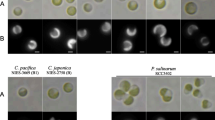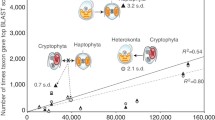Abstract
As the only remainder type of phycobiliproteins in Prochlorococcus, the actual role of phycoerythrin still remains unknown. Previous studies revealed that two different forms of phycoerythrin gene were found in two ecotypes of Prochlorococcus that are specifically adapted to either high light (HL) or low light (LL) conditions. Here we analyze patterns of phycoerythrin nucleotide variation in the HL- and LL-Prochlorococcus populations. Our analyses reveal a significantly greater number of non-synonymous fixed substitutions in peB and peA than expected based on interspecific comparisons. This pattern of excess non-synonymous fixed substitutions is not seen in other five phycoerythrin-related genes (peZ/V/Y/T/S). Several neutrality statistical tests indicate an excess of rare frequency polymorphisms in the LL-Prochlorococcus data, but an excess of intermediate frequency polymorphisms in the HL-Prochlorococcus data. Distributions of the positively selected sites identified using the likelihood ratio test, when mapped onto the phycoerythrin tertiary structure, reveal that HL- and LL-phycoerythrin should be under different selective patterns. These findings may provide insights into the likely role of selection at the phycoerythrin locus and motivate further research to unveil the function of phycoerythrin in Prochlorococcus.
Similar content being viewed by others
References
Apt KE, Collier JL, Grossman AR, (1995) Evolution of the phycobiliproteins. J Mol Biol 248:79–96
Deng HW, Fu YX (1996) The effects of variable mutation rates across sites on the phylogenetic estimation of effective population size or mutation rate of DNA sequences. Genetics 144:1271–1281
Doust AB, Marai CNJ, Harrop SJ, Wilk KE, Curmi PMG, Scholes GD (2004) Developing a structure-function model for the cryptophyte phycoerythrin 545 using ultrahigh resolution crystallography and ultrafast laser spectroscopy. J␣Mol Biol 344:135–153
Dufresne A, Salanoubat M, Partensky F, Artiguenave F, Axmann IM, Barbe V, Duprat S, Galperin MY, Koonin EV, Gall FL, Makarova KS, Ostrowski M, Oztas S, Robert C, Rogozin IB, Scanlan DJ, Tandeau N, de Marsac Weissenbach J, Wincker P, Wolf YI, Hess WR (2003) Genome sequence of the cyanobacterium Prochlorococcus marinus SS120, a nearly minimal oxyphototrophic genome. Proc Natl Acad Sci USA 100:10,020–10,025
Dufresne A, Garczarek L, Partensky F (2005) Accelerated evolution associated with genome reduction in a free-living prokaryote. Genome Biol 6:R14
Fay JC, Wu C-I (2001) The neutral theory in the genomic era. Curr Opin Genet Dev 11:642–646
Felsenstein J, (1989) Phylogeny inference package (version 3.2). Cladistics 5:164–166
Ford MJ (2002) Applications of selective neutrality tests to molecular ecology. Mol Ecol 11:1245–1262
Fu YX, Li WH (1993) Statistical tests of neutrality of mutations. Genetics 133:693–709
Guex N, Peitsch MC (1997) SWISS-MODEL and the Swiss-PdbViewer: an environment for comparative protein modeling. Electrophoresis 18:2714–2723
Hess WR, Partensky F, Van der Staay GWM, Garcia-Fernandez JM, Börner T, Vaulot D (1996) Coexistence of phycoerythrin and a chlorophyll a/b antenna in a marine prokaryote. Proc Nat Acad Sci USA 93:11,126–11,130
Hess WR, Steglich C, Lichtle C, Partensky F (1999) The phycoerythrins of Prochlorococcus marinus are associated to the thylakoid membrane and are encoded by a single large gene cluster. Plant Mol Biol 40:507–521
Hess WR, Rocap G, Ting CS, Larimer F, Stilwagen S, Lamerdin J, Chisholm SW (2001) The photosynthetic apparatus of Prochlorococcus: insights through comparative genomics. Photosynth Res 70:53–71
Holtzendorff J, Marie D, Post AF, Partensky F, Rivlin A, Hess WR (2002) Synchronized expression of ftsZ in natural Prochlorococcus populations of the Red Sea. Environ Microbiol 4:644–653
Hudson RR (1990) Gene genealogies and the coalescent process. Oxf Surv Evol Biol 7:1–44
Lokstein H, Steglich C, Hess WR (1999) Light-harvesting antenna function of phycoerythrin in Prochlorococcus marinus. Biochim Biophys Acta 1410:97–98
McDonald JH, Kreitman M (1991) Adaptive protein evolution at the Adh locus in Drosophila. Nature 351:652–654
Misawa K, Tajima F (1997) Estimation of the amount of DNA polymorphism when the neutral mutation rate varies among sites. Genetics 147:1959–1964
Nei M, Li WH (1979) Mathematical model for studying genetic variation in terms of restriction endonucleases. Proc Natl Acad Sci USA 76:5269–5273
Nielsen R, Yang ZH (1998) Likelihood models for detecting positively selected amino acid sites and applications to the HIV-1 envelope gene. Genetics 148:929–936
Nielsen R (2005) Molecular signatures of nature selection. Annu Rev Genet 39:197–218
Palenik B, Brahamsha B, Larimer FW, Land M, Hauser L, Chain P, Lamerdin J, Regala W, Allen EE, McCarren J, Paulsen I, Dufresne A, Partensky F, Webb EA, Waterbury J (2003) The genome of a motile marine Synechococcus. Nature 424:1037–1042
Partensky F, Hess WR, Vaulot D (1999) Prochlorococcus, a marine photosynthetic prokaryote of global significance. Microbiol Mol Biol Rev 63:106–127
Qin S, Zhao FQ, Tseng CK (2005) Evidence for positive selection in phycoerythrin genes of red algae and cyanobacteria Prochlorococcus and Synechococcus. Photosynthetica 43:141–146
Rambaut A, Grassly NC (1997) Seq-Gen: an application for the Monte Carlo simulation of DNA sequence evolution along phylogenetic trees. Comput Appl Biosci 13:235–238
Rozas J, Rozas R (1999) DnaSP version 3: an integrated program for molecular population genetics and molecular evolution analysis. Bioinformatics 15:174–175
Rocap G, Larimer FW, Lamerdin J, Malfatti S, Chain P, Ahlgren NA, Arellano A, Coleman M, Hauser L, Hess WR, Johnson ZI, Land M, Lindell D, Post AF, Regala W, Shah M, Shaw SL, Steglich C, Sullivan MB, Ting CS, Tolonen A, Webb EA, Zinser ER, Chisholm SW (2003) Genome divergence in two Prochlorococcus ecotypes reflects oceanic niche differentiation. Nature 424:1042–1047
Steglich C, Psot AF, Hess WR (2003a) Analysis of natural populations of Prochlorococcus spp. in the northern Red Sea using phycoerythrin gene sequence. Environ Microbiol 5:681–690
Steglich C, Mullineaux CW, Teuchner K, Hess WR, Lokstein H (2003b) Photophysical properties of Prochlorococcus marinus SS120 divinyl chlorophylls and phycoerythrin in vitro and in vivo. FEBS Lett 553:79–84
Swofford DL, Waddell PJ, Huelsenbeck JP, Foster PG, Lewis PO, Rogers JS (2001) Bias in phylogenetic estimation and its relevance to the choice between parsimony and likelihood methods. Syst Biol 50:525–539
Tajima F (1989a) Statistical method for testing the neutral mutation hypothesis by DNA polymorphism. Genetics 123:585–595
Tajima F (1989b) DNA polymorphism in a subdivided population: the expected number of segregating sites in the two-subpopulation model. Genetics 123:229–240
Tajima F (1996) The amount of DNA polymorphism maintained in a finite population when the neutral mutation rate varies among sites. Genetics 143:1457–1465
Thompson JD, Higgins DG, Gibson TJ (1994) CLUSTAL W: improving the sensitivity of progressive multiple sequence alignment through sequence weighting, position-specific gap penalties and weight matrix choice. Nucleic Acids Res 22:4673–4680
Ting SC, Rocap G, King J, Chisholm SW (2001) Phycobiliprotein genes of the marine photosynthetic prokaryote Prochlorococcus: evidence for rapid evolution of genetic heterogeneity. Microbiology 147:3171–3182
Wall JD (1999) Recombination and the power of statistical tests. Genet Res Camb 74:65–79
Watterson GA (1975) On the number of segregating sites in genetical models without recombination. Theor Popul Biol 7:256–276
Wilbanks SM, de Lorimier R, Glazer AN (1991) Phycoerythrins of marine unicellular cyanobacteria. III Sequence of a class II phycoerythrin. J Biol Chem 266:9535–9539
Wong WSW, Yang ZH, Goldman N, Nielsen R (2004) Accuracy and power of statistical methods for detecting adaptive evolution in protein coding sequences and for identifying positively selected sites. Genetics 168:1041–1051
Yang ZH (1997) PAML: a program package for phylogenetic analysis by maximum likelihood. CABIOS 13:555–556
Yang ZH, Nielsen R, Goldman N, Pedersen AM (2000) Codon substitution models for heterogeneous selection pressure at amino acid sites. Genetics 15:1600–1611
Yang ZH, Nielsen R (2002) Codon-substitution models for detecting molecular adaptation at individual sites along specific lineages. Mol Biol Evol 19:908–917
Zhao FQ, Qin S (2006) Positive selection drives the phycobiliproteins diversification in the cyanobacterial light-harvesting apparatus evolution. J Mol Evol (in press)
Acknowledgments
We thank two anonymous reviewers for valuable comments and suggestions. This work was supported by grants from Key Innovative Project (KZCX3-SW-215) of the Chinese Academy of Sciences.
Author information
Authors and Affiliations
Corresponding author
Rights and permissions
About this article
Cite this article
Zhao, F., Qin, S. Comparative molecular population genetics of phycoerythrin locus in Prochlorococcus . Genetica 129, 291–299 (2007). https://doi.org/10.1007/s10709-006-0010-9
Received:
Accepted:
Published:
Issue Date:
DOI: https://doi.org/10.1007/s10709-006-0010-9




